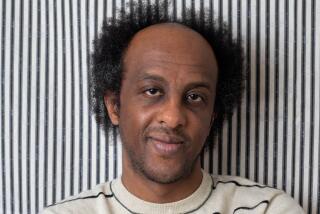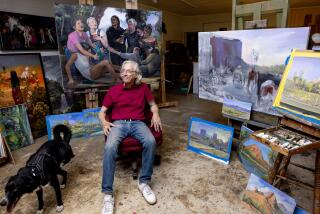Beauty, but only on canvas
- Share via
Mogadishu, Somalia — HIS T-shirts read “Beautiful Mogadishu,” with a hand-painted background of a Somali flag or a camel. Foreigners in this wasted capital buy them as souvenirs, chuckling at the irony. But the man behind the shirt isn’t laughing.
They call him Happy Arts, and the Mogadishu-born artist said he uses his craft to spread hope in a city that has seen little.
“I paint to show people another time, so they will remember Mogadishu was once beautiful,” said the 30-year-old artist, whose real name is Abdulkhadir Aweys Abdi.
In the front of his tiny shop are oil paintings of cheerful scenes. Bucking impalas, children playing or smiling women. Sales are sparse, he said, because few people these days have money to splurge. But for years, he has supported a wife and nine children by peddling hand-painted T-shirts, commercial signposts and the occasional portrait.
Hidden in the back of the tin-roofed shack are a collection of darker creations he painted secretly over the years. After some nudging, he agreed to dig out the large canvases. They depict a far different Somalia, one of civil war and starvation, street fights and drowning refugees. His technique is coarse, the message overt.
They are his passion and his pride. One painting shows a collage of scenes from Somalia’s recent past, from the artillery attack that destroyed the parliament building to bloodied bodies from a clan war. In the center of the piece is a woman’s anguished gaze, tears streaming down her face.
He refuses to sell these darker pieces. He said he’s saving them for history, for an exhibition he dreams of holding after Mogadishu’s problems end.
“This is the civil war,” he said, motioning to the work. “I’m keeping a record.”
Happy is a short man, about 5 foot 4, with a round belly and fat cheeks. He and his studio smell faintly of fresh-baked bread, suggesting baker more than painter.
By age 10 he was studying with a local artist. When he was 15, the military dictatorship of Mohamed Siad Barre collapsed and Somalia began a 16-year plunge into violence, clan war and lawlessness. Happy never finished high school.
As an artist, the suffering has been inspirational, he said. In the early days of the civil war, Happy’s secret paintings reflected the gritty reality he was witnessing. As a Somali, however, it’s been too painful to watch. Now he paints what he remembers, or what people describe to him, because he can no longer bear to see the decline of his beloved city.
His shop stands on what was once one of the capital’s grandest shopping avenues, a tree-lined street with grassy medians and posh shops selling Italian-made clothing and ivory. Today it’s a dusty, congested thoroughfare of fruit stands, auto parts stores and mobile phone kiosks.
A few months ago, after an alliance of religious leaders known as the Islamic Courts Union restored security to the streets, Happy considered fixing up his shop or moving to a better area.
U.S. officials accused the courts of having links to terrorists, but they won praise in Mogadishu for reducing crime and unifying the city. Last month, Ethiopian-led troops helped Somalia’s transitional government defeat the Islamists.
Facing yet another new authority in Mogadishu, Happy is putting his renovation plans on hold to see whether the transitional government can maintain order.
On a drive down the capital’s coastline, Mogadishu’s descent is reflected in his eyes. The salted warm breeze from the Indian Ocean remains strong, but today the city center, once filled with museums, monuments, government buildings and parks, is deserted, a modern-day ruin.
Only the bombed-out frames of ornate Italian columns and archways are left. Sand, cactus and weeds creep through glassless windows and doorways. Any material of value, such as glass, wire or pipes, was looted long ago. All that’s left of the parliament building is a rectangular tower, its exterior walls blown apart, revealing an interior staircase to nowhere. The once-trendy Lido Club, whose dance floor overlooked the crashing waves below, is a ghost disco.
“It turned into this very slowly,” Happy said. Bit by bit, he watched the civil war claim the city.
He stopped at an empty intersection, once one of the capital’s most congested. “This used to be my favorite spot. I used to sit there and watch children play.” He pointed to a two-story pile of rubble across the street.
“This was where I came to learn to paint,” he said quietly. “My teacher had a studio there.” He shook his head. “It shocks me every time I see this building. I don’t come here anymore. I don’t like to see my school in ruins. It reminds me of when life was better.”
The Mogadishu of his childhood was a time of traffic lights and picnics and going to movies with his father. He used to love swimming in the blue waters. He hasn’t dipped a toe into the Indian Ocean since 1994, after United Nations and U.S. troops withdrew from Somalia. It’s too unsafe, he said, and probably polluted. “All that is over.”
He said he couldn’t help but pity his own children, ranging in age from 1 month to 13 years.
“My children are kept in the house,” he said. “I was very lucky when I was young. I saw Mogadishu when it was beautiful. But my children have never seen those places. They only see the destruction and pollution.”
Not far away, through some narrow, twisting alleyways, Happy stopped at a large tree standing in a patch of dirt surrounded by small shacks.
“I was born under that tree,” he said. His childhood home, however, was destroyed by stray artillery in 1996, when the family had temporarily fled the city. Neighbors and scavengers looted the remains to rebuild their own damaged homes. “Now it doesn’t look like there was ever a house here,” he said.
He hopes to rebuild one day, but the neighborhood has changed. When he was a boy, middle-class families here planted gardens and painted their homes. The government fined anyone leaving trash around. Now the area, almost a slum, is inhabited by squatters.
Around the corner, his former elementary school is still open. He spoke of learning Arabic and geometry, and playing soccer in the large square in front of the school.
Several months ago, a local Islamic court used the square for a public execution in which an accused murderer was stabbed to death, a scene so grisly that spectators fled vomiting. Students were among those watching.
Happy stayed away. At the beginning of the civil war, he said, he felt a responsibility to personally witness the scenes of destruction. After a couple of years, he found the trauma too much to stomach. “Now I ask people to describe it,” he said. “I can’t look anymore.”
LIKE many in Mogadishu, however, he ventured out in 1993 to see a downed U.S. helicopter, part of a failed mission to pressure one of the city’s warlords. Eighteen American servicemen died in the attack, which was later memorialized in the book and movie “Black Hawk Down.” Bodies of some servicemen were dragged through the streets. A few months later, President Clinton withdrew U.S. forces.
“There was chaos and violence everywhere that day. The wreckage was over there,” he said, pointing to an intersection. Today the area is largely abandoned, the shops closed. Some children played soccer on a nearby field.
He said he views his job as part artist, part journalist. “I paint the current issues. I paint the problems of Somalia.”
At times his vision clashed with Mogadishu’s ever-changing authorities. In 1996, the militiamen of warlord Mohamed Farah Aideed questioned him about the hidden meaning of one piece depicting a giant snake strangling a leopard while a smiling monkey looks on. Who is the snake, they demanded. Is my tribe the snake? They believed the leopard represented Somalia being squeezed by their clan, and the smiling monkey signified the international community, watching from the sidelines. He convinced them that the painting had no meaning and they left him alone.
Back at his art shop, Happy disappeared into his back room again and emerged with another piece. This one represented the future of Mogadishu, with almost cartoonish colors depicting a blue sky filled with balloons, clear waters and grass-covered blocks sandwiched between neat streets.
This idyllic vision contrasts sharply with the gritty street outside. Is Mogadishu beautiful, as his T-shirts claim?
“No,” he said. “Mogadishu is not beautiful anymore.... But I hope I’m alive to see the city peaceful again.”
Sanders was recently on assignment in Mogadishu.
More to Read
Sign up for Essential California
The most important California stories and recommendations in your inbox every morning.
You may occasionally receive promotional content from the Los Angeles Times.










